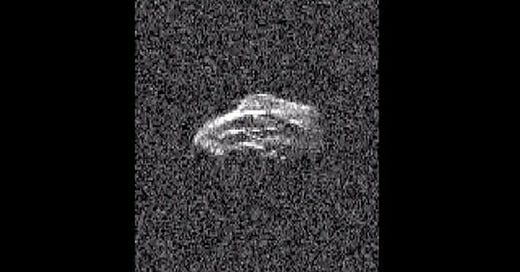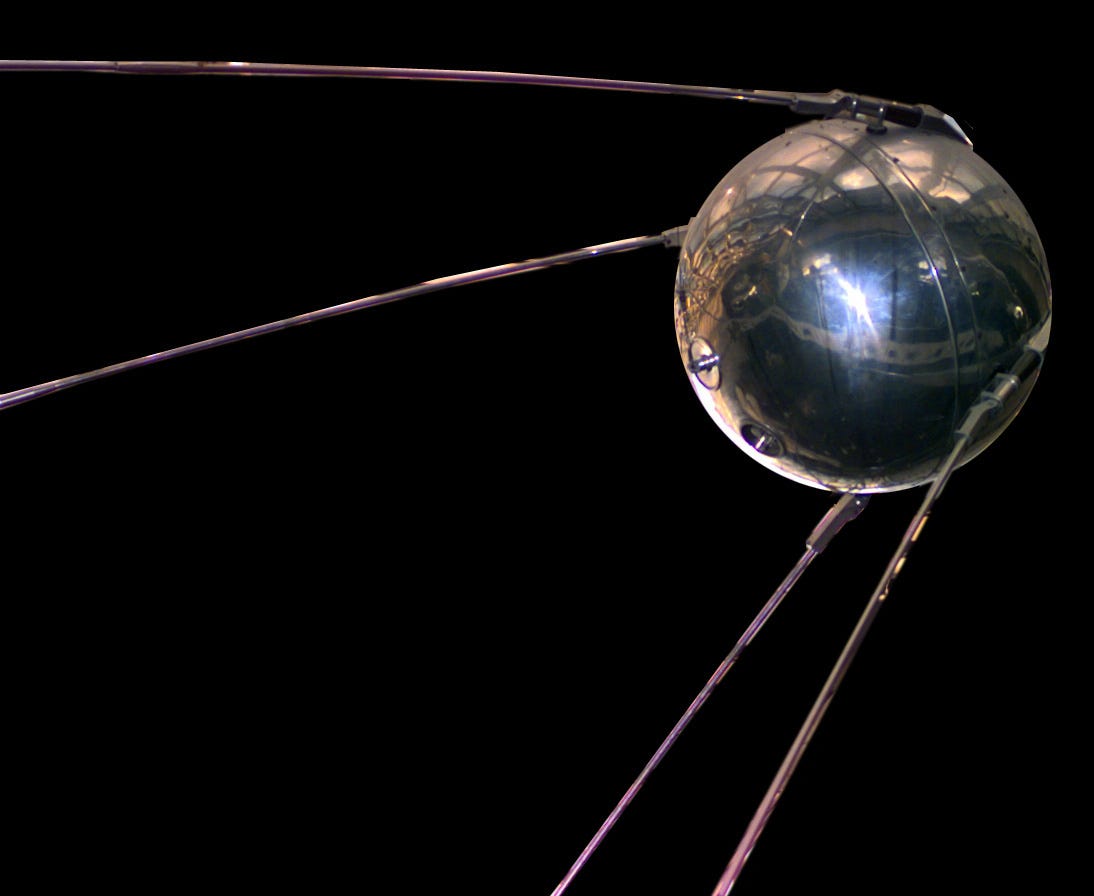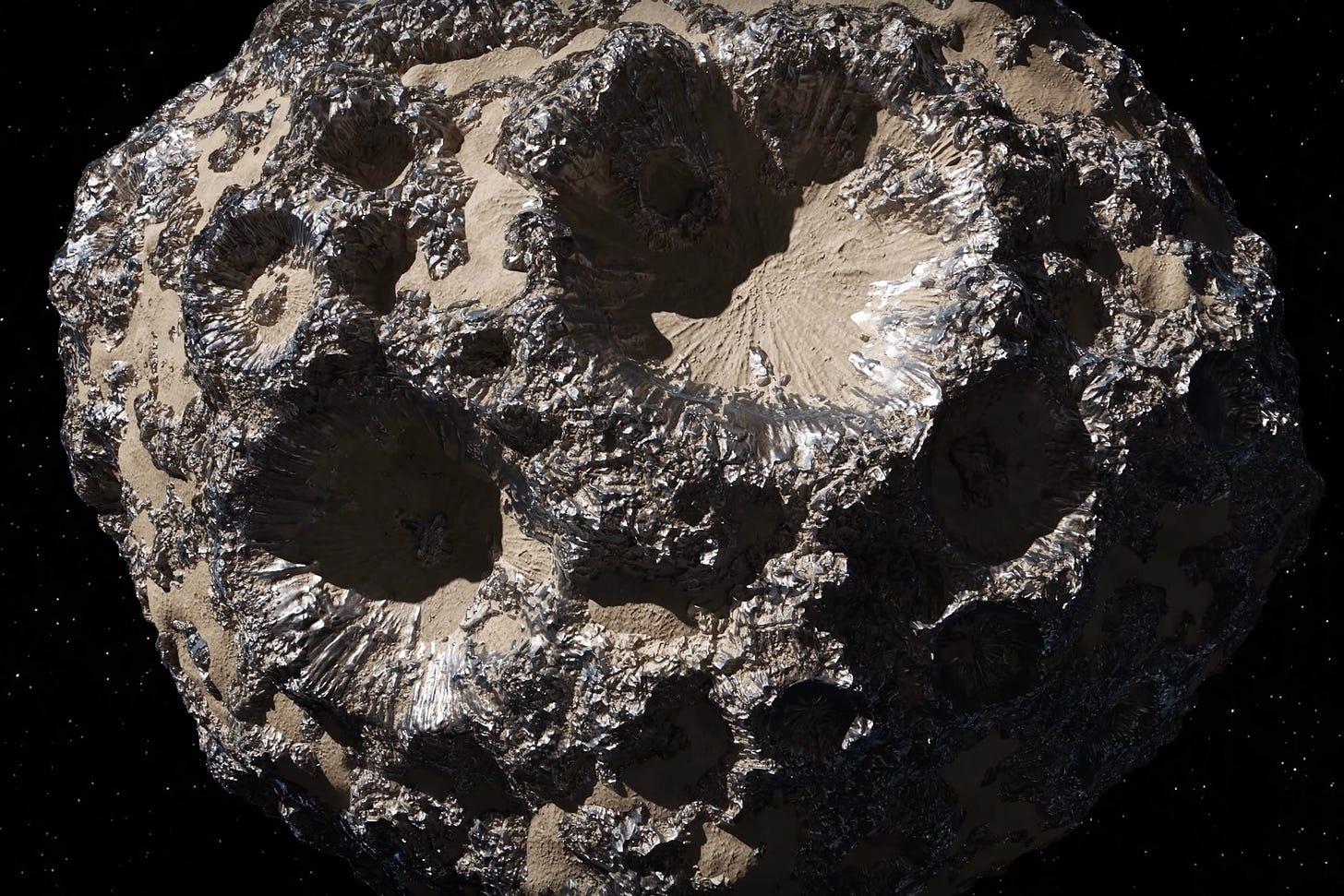Many years ago, in the last quarter of the last century of the prior millennium, there was a good group of people organised by H. Keith and Carolyn Henson (now Carolyn Meinel) called the L5 Society. One day, perhaps, a detailed obituary of its birth, life, betrayal, and death should grace these digital ‘pages’ but that is not this day. On this day, we will discuss a bumper sticker that once was conceived by Greg Barr and distributed through the L5 Society from their headquarters in Tucson, Arizona. I owned a copy of this bumper sticker which said, very simply, “Save the Earth” on one line and “Develop Space” on the line below. The Earth was depicted against a black background. I’ve not been able to locate an image of it online, but there’s bound to be a reader who remembers it. I might have one in a box in storage in Ohio.
Why should we mine the Earth? There’s plenty of every mineral in the sky.
Consider just two examples. One, called UW158, is an Earth approaching asteroid which has enough platinum group metals to be worth about US$5 trillion. Here’s a picture that NASA took with your money, so you should probably be allowed to see it. Of course, I don’t ever charge money for this publication, because the filth who run NASA would probably sue me for daring to present tax-funded images here if I did. Because NASA is run by evil, hateful, demon worshipping scum, in my experiences of them.
If you click on that image, or click here, you can read a bit about the asteroid, its recent approach, and the estimate of its value. Of course, it is “some trick” as we used to say, to go out to a Solar orbit, maybe exiting the Earth-Moon system by way of L2 in the Sun-Earth system, and voyaging off to see UW158. Even trickier would be to adjust its orbit to, perhaps, intersect the lunar surface and become available for mining activities. Even trickier to get it into a low eccentricity orbit around Earth for in-space mining. Estimates range from about five billions up to tens of billions of dollars for such a mission, or set of missions.
Now, why would you mine asteroidal materials and refine them for use in orbit? Well, lots of reasons. Nickel-iron asteroids have lots of useful materials for a technological civilisation. Arguably, refined platinum would even be worth returning to Earth for sale in the commodities market. Certainly the things we use platinum for on Earth have applicability to similar activities in space. (A report from an outfit called WPIC says that there is a “platinum deficit for 2023 … around 983,000 ounces,” which is quite a lot of platinum at today’s price of $974/ounce.)
It says here that platinum is used, “… in the chemicals industry as a catalyst for the production of nitric acid, silicone and benzene. It is also used as a catalyst to improve the efficiency of fuel cells. The electronics industry uses platinum for computer hard disks and thermocouples.” Which brings to mind some discussions we had long ago, in what seems like another country, (“and besides, the wench is dead,” to abuse an old Christopher Marlowe line).
During the Autumn of 1982, I travelled to Boston, where I met Christine Peterson and K. Eric Drexler at a very nice seafood restaurant for lunch. I was but a poor undergraduate student, living on work-study and struggling with scholarship funds to cover some of my tuition. My hostess and host were kind enough to stand me to the meal. We discussed the possibilities of my starting with Carmi Weinzweig a joint chapter of L5 Society and the Planetary Society, something that had never previously been attempted. As it happened, it worked pretty well, and we launched model rockets from the sundial on campus and held a number of interesting meetings, including a few late night excursions to use the large optical telescope atop Pupin Hall. (It wasn’t difficult to walk along a ledge, access an unlocked and nearly broken door at the back of the dome, contort one’s body to fit into the interior stairway, and open the regular door, after which, if one had taken note of the location of the objective lenses, one could have fun watching the sky, looking at planets, and seeing whether the ‘scope would depress close enough to the horizon to get a look at the coeds in the upper floors of certain dormitories.)
Here are a few words that K. Eric wrote back in 1983 about some of the reasons why the L5 Society was for space development. “Space development also makes sense for the sake of the environment; however, it provides an area where industrialists and environmentalists need have no conflict. Building industry in space can eventually reduce the burden of industry on Earth. As industry spreads, it will help spread life into lifelessness, continuing a tradition set by the first plants to spread green across Earth’s barren continents.”
The purpose of moving industry into orbit is both to serve orbital activities, such as space habitat construction and solar power satellite building, and to move dirty industries like metal refining and chemical industries into places where “pollution” doesn’t affect an existing biome. We used to say things like, “There are no blue whales on the Moon and no spotted owls on Mars.” Mind you, there are some die hard extremists who will assert, falsely and often in an evil voice, that mankind should never be allowed to “pollute” the Moon’s pristine environment with our icky existence. To which I say, God gave mankind dominion over the earthly realm. You can look it up.
K. Eric had some other trenchant comments about the opportunities for developing space resources. For example, he wrote, “Further, space development can help promote peace by reducing tension over resources. The limits-to-growth idea implied that the poor must be kept poor, if the less-poor are to delay their own doom. By making life seem a zero-sum game, it set people in conflict. The vision of a future with Earth open to the vaster world of space directly destroys this myth. By giving hope, lifting an apparent death-sentence on civilization, it helps encourage people to tackle the real problems posed by our exploding technology.”
Of course, Earth is open to space, it is not inside of a box. The idea of a fixed resource base is demonstrably false, since we are always receiving sunlight, micro-meteors, and information from space. There are thousands of Earth orbiting satellites that we’ve launched since the early days of space. Oh, sure, there were fools in the Pentagon who told my buddy G. Harry Stine’s boss to put sand in the upper stage of the Thor Delta Star he was working on, roughly 1954, but eventually people began putting things in orbit, not much later. And here we are decades later, wondering when scheduled passenger space travel will be available for destinations like the lunar surface.
Gravity Matters
Now, a part of me can almost hear the puzzlement of technologists seeing my suggestion of crashing UW158 into the Moon. “Why do that?” I pretend to hear them ask. Well, because metal refining operations in microgravity might be a lot more complicated than refining operations in one-sixth gravity. There used to be a lot of arm waving arguments at science fiction conventions and at international space development conventions back in the day. Some of these struck me as based on a very limited practical understanding of reality.
If you look at the people and equipment that exist on Earth for the purpose of refining metals, these are not trivial undertakings. And all that equipment, all those processes, were designed and implemented in a one-gravity environment. So, waving your hands about and saying, “Oh, we’ll just rotate the asteroid to get whatever gravity we want,” may sound clever, but does it work that way? What are the Coriolis forces like?
Imagine a giant cylinder, built by people some decades in the future. Let’s say it is six miles long and a mile in diameter. Great! (No, I have no intention of converting to the metric system, get a grip Napoleon enthusiasts.) So we rotate it about its long axis and we have a nice stable pseudo-gravity “field” for people living and working in their interior of this hollow cylinder.
Um, no. See, it won’t be stable. Professor Gerard O’Neill pointed out the problem. Coning, as we say in rocketry, is a problem with spin stabilised objects. The planet you are on does the same thing. We call it “precession of the equinoxes.” Any spinning object exhibits precession. That’s why a spinning top eventually tips over. It is spin stabilised, but it is not entirely, perfectly, dynamically stable forever. Dr. O’Neill’s solution was to link two such cylinders together at one end, and run the spin backwards for one compared to the other. That way they are more stable as a pair.
A torus has somewhat different issues, so feel free to imagine a spinning toroid, like you see in the 1968 film “2001: A Space Odyssey.” The point, though, is, what would it be like playing baseball or tennis inside one of these space habitats? Sure, the spin can be appropriate to simulate one gravity at the inner surface of the cylinder or toroid, but gravity is not the only force involved. The spin of the Earth generates Coriolis forces, so you have much different wind speeds at the Equator compared, to, say, the latitude of Alberta where we call fast moving storms “Alberta clippers.” And those Coriolis forces are going to change the way a long throw from centre field works, for the particular baseball thrown inside a space colony. Takes getting used to.
Refining metal, however, is not an athletic competition. So it might be well to have an actual gravity field rather than just make inane assumptions about how we’ll “simply rotate the asteroid to get the desired accelerations.” Because the number of asteroids we, as a species, in our current civilisational development, have rotated to suit our preferences is exactly zero. Whereas once an Earth-approaching asteroid is an astro-bleme on the surface of the Moon, the adaptation of equipment and processes to a one-sixth gravity field might be quite a lot less complicated. Still sufficiently complicated, mind you, given the very little atmosphere on the lunar surface and other factors.
Large Space Structures
In order to make things in space, so far, mankind have lifted from Earth’s surface quite a lot of stuff. It won’t always be that way, because the Earth is deep down in the bottom of a gravity “well.” So there’s a lot of thrust you need to apply to stuff down here at the surface to get it up there into orbit. Well, you can get things into a sort of orbit just by tossing them a bit. A baseball on a high arc to centre field is in orbit, but the orbit it is in never leaves the atmosphere, and intersects the Earth. Which is desirable for the guy trying to catch the ball so the batter is “out.” But less desirable for the orbital habitat projects.
Earth is not the only gravity well in the Solar system. There are tens of thousands of planetoids with minor gravity wells, and roughly nine planets (depending on whether you agree with Neil Tyson that astronomers should vote on whether Pluto is a planet) to choose from. One of those planetoids was discovered in 1852 and is called Psyche. It weighs in at 2.72 × 10^19 kilogrammes. Now, divide by a thousand to get metric tonnes, that’s easy, just knock off three zeroes. Making it 2.72 × 10^16 tonnes.
Gosh, that’s a big number Jim, what does it mean? Well, a trillion is 10^12. So a quadrillion must be 10^15. Which makes the figure 27.2 quadrillion tonnes. That’s a big asteroid. It orbits in what we now call the Main Belt. Many years ago, physicist Freeman Dyson said, “Once we get to the Main Belt asteroids, the IRS will never find us.” -smile-
Psyche has a mean diameter of about 140 miles. It is sometimes called “16 Psyche” because it was the 16th “minor planet” discovered. It is one of the most massive asteroids in our star system, being made of metal. Based on bouncing radar and other light off it, we have some sense of its composition. It includes several areas which show dense metal, and others where silicate materials are found. It orbits the Sun between 2.5 and 3.3 astronomical units from the Sun. (One astronomical unit is the distance from the Sun to the orbit of Earth.) So you find it between the orbits of Mars and Jupiter.
Which means when we get done harvesting some of the closer, Earth approaching asteroids, we can set our sights on the Main Belt and find quite a few interesting places to visit. The resources for a technological civilisation are already out there. And that’s what makes frontier people successful, finding ways to use in-situ resources. Which is a set of topics for future essays on this substack.







Looks like a new estimate for 16 Psyche is $10 quintillion. https://finance.yahoo.com/news/asteroid-loaded-10-quintillion-worth-043143459.html